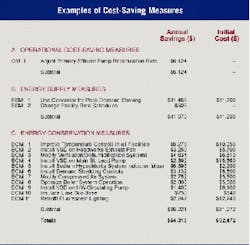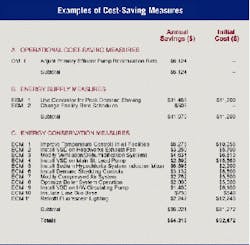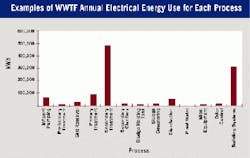Contract Operators Focus on Reducing Energy Costs
By Steve Bolles
Staff at water and wastewater facilities are constantly challenged to trim costs and improve the energy efficiency of their operations. Contract operations firms can often assist with this effort by supplementing existing staff with experts specializing in process, maintenance, operations, and energy.
The contract operator may be tasked with improving facility efficiency as part of a long- term operations contract where improvement costs and savings are factored into fixed annual payments, or may have a limited "consultant" role where their efforts are focused on assisting facility staff in developing their own efficiency program based on the contract operator's experience.
This article is focused on the process a contract operator goes through to evaluate how to improve facility efficiency when an RFP has been developed for a comprehensive multi-year operations contract. However, the steps described can be applied to any organization interested in developing a plan to improve facility efficiency.
Getting Started
Learning all there is to know about a facility is one of the first steps needed to develop projects focused on reducing operating costs. This learning phase begins as soon as a facility decides to consider contract operations and issues a Request for Proposals for those services. From that initial step of learning and on through project startup, the contract operator gets organized for results by:
- thoroughly reviewing each facility system and collecting operational data on each piece of equipment;
- brainstorming and analyzing potential projects that will help reduce operating costs;
- organizing an energy management team;
- implementing cost-saving projects; and
- starting up, training, monitoring and verifying project results.
Site Review
When the site visits begin, a contract operator organizes a team of technical O&M specialists who are hands-on experts in specific areas. The team may include specialists for process, maintenance, operations, and energy. After a general plant tour and a review of O&M costs, each of these technical specialists focuses on facility improvements that have the greatest potential to reduce operating costs. Key areas of consideration include:
- Assembling a list of all equipment with detailed nameplate information and holding discussions with plant operators to determine hours of operation. This data can be used to develop a summary of energy use for each process;
- Reviewing equipment operation to determine if the system is operating efficiently (e.g., throttled discharge valves on pump systems, inoperable equipment operation controls, optimizing system operation through process adjustments, improving the efficiency of heating and ventilation system components, replacing standard efficiency motors with high efficiency units); and
- Reviewing energy sources and costs to determine if alternative fuels should be considered for systems and equipment.
Brainstorming
After the initial site visit, the contract operations team brainstorms ideas and determines what level of effort would be required for the proposed projects. Additional visits or data collection may be needed to help quantify potential savings and costs. One difficulty at this stage is the limited data that can be obtained during the RFP process. Often times careful assumptions must be made during this process, including the potential "down-side" of incorrect values.
The proposed improvements recommended for a facility start with easy, low-cost operability improvements and progress to major investments that could reduce O&M costs substantially. (See example shown in Table 1.) Typically, the brainstorming begins with broad questions such as:
Can equipment be turned off periodically or adjusted to reduce output?
This may include cycling sludge holding tank blowers on and off, reducing dissolved oxygen levels in the aeration system, shutting fans off in selected areas during the evening hours, or reducing temperatures in pump stations. These adjustments may require some input from other team members to evaluate the impact of the changes. For example, cycling the sludge holding tank blowers on and off may create an odor problem at the facility, or reducing the temperature in a process area with polymer storage may impact polymer performance.
Can equipment efficiency be improved through the use of new equipment or technology?
Applying variable speed drives to pump systems, installing new instrumentation and control systems, replacing old equipment with new high-efficiency equipment, and looking at alternative process technologies are reviewed in detail. Experience is an important consideration for this step since the contract operator has a "portfolio" of previous cost-saving projects completed at other facilities.
When capital must be invested to realize the savings, a detailed cost-benefit analysis must be made. A life-cycle cost analysis approach is critical to account for all foreseeable benefits and expenses related to the proposed improvements. The old approach of using a simple payback to justify improvements does not provide a meaningful analysis unless maintenance, labor, and the time value of money are included in the analysis.
Since operations contracts are becoming more comprehensive and stretch over a longer period of time, the contract operator can consider projects that pay for themselves in seven to 10 years, versus a 2- to 4-year time period that is the typical threshold for some municipalities and industries.
Energy Alternatives
Contract operations energy managers have the advantage of dealing with energy suppliers on a regular basis and can recognize when it makes sense to pursue becoming part of an energy purchasing group, staying with an electric utility "standard offer," switching rate schedules, or changing to alternative fuel or generation sources. Cogeneration or use of existing emergency generators for peak shaving could also be an opportunity to reduce costs (making sure air permit requirements are considered). Eventually all viable projects are assembled in a comprehensive plan of improvements that can be presented in the proposal. When capital improvements are part of the contract operator's responsibility to implement and finance, the project becomes the ultimate "performance contract," where the operator is not only responsible for making the improvements but also directly impacted by the actual realized savings, maintenance costs, effect on labor, and the impact on water quality.
Developing multiple cost-savings projects quickly and accurately in a 6- to 8-week time frame requires an experienced group of specialists that can assess the risks and rewards of each project based on past experiences. Unproven new technologies are approached cautiously since cost overruns and unrealized savings can quickly erase any project profit.
Management team
Upon contract award, work begins for the contract operator's transition team. This is when all the ideas presented in the proposal must be implemented as quickly as possible to realize the anticipated savings. To develop a solid base of staff participation, communication and accountability, an energy team for the facility is created. This typically consists of the energy manager, the plant manager, and maintenance and operations staff. The area manager and principal in charge of the contract also attend the meetings to support the team and emphasize the importance of working together to implement the energy management plan. As more input is received from the staff, adjustments are made to the plan.
For some facility staff who transition from being employed by the municipality to a private operator, it becomes immediately apparent that improving efficiency is a high-priority task that is a key part of the operations plan. A contract operator cannot accept that it "can't be done" until every reasonable approach is thoroughly pursued since operational budgets include the projected savings developed in the proposal stage.
Immediate goals of the energy management team include:
- Developing a long-term meeting schedule and reviewing the proposed project implementation schedule.
- Creating an energy team "charter" that defines the purpose of the team and how it is organized.
- Identifying roles and responsibilities and how team staff will be accountable.
Reviewing projects with staff to determine what projects will require additional technical assistance to fully develop the projects presented in the initial proposal or if supplemental engineering is needed.
Identifying how staff can be rewarded for their efforts and how a successful project can be promoted after verifying savings.
Identifying what efficiency tools will be incorporated into daily equipment monitoring and providing training for use of these tools. This includes the use of spreadsheets and data collection sheets for:
- extracting energy use information from utility bills and benchmarking use with water or wastewater production and treatment parameters;
- using software such as the Pump Systems Assessment Tool (PSAT) from the U.S. Department of Energy Motor Challenge Program to monitor pump system efficiency;
- setting up a computerized maintenance management program to track maintenance costs; and
- collecting process and equipment use data during daily rounds to quantify existing performance of each system.
After the first energy management team meeting, the energy manager's role shifts from an evaluator to a project developer. After several projects are under way, the team transitions from an "energy team" to an "efficiency team," since other cost-savings projects that reduce chemical use, sludge costs or maintenance expenses can also be approached in a similar manner.
Project Implementation
After the projects have been delegated to the various team members during the first energy team meeting, decisions are made on how each project will be developed based on the project's complexity. Project delivery methods include:
- project implementation using facility staff resources (typical for operational adjustments);
- developing performance-based work packages that are bid to specialized contractors (an example may be a generator replacement that is a turn-key project or upgrading existing lighting to high-efficiency lighting);
- design-build approach that requires engineering from multiple disciplines and subcontracting work to multiple trades; and
- design-bid-build projects that are handed off to a municipal engineering firm to develop and bid to general contractors.
Whatever project delivery option is chosen, an O&M specialist is assigned to the project to develop a work plan, coordinate contractors, provide contract administration, interface with facility staff, and track budgets and schedules.
Since multiple projects may be pursued simultaneously, it is the project developer's job to verify progress, manage resources, communicate progress and problems to senior management, and transition from one project to another without over committing staff. To do this successfully, he must have a team of "hands-on" O&M specialists assigned to specific projects at multiple facilities. These individuals are responsible for all on-site work with facility staff, managing subcontractors, ordering materials and equipment, and keeping the project developer informed of progress and resources required.
Project Results
A contract operator knows the importance of a thorough equipment start-up that includes equipment performance testing, comprehensive training, detailed O&M manuals, and developing easy-to-use standard operating procedures. It's not enough for operators and maintenance personnel to understand the operation and maintenance of the equipment. They must also learn how to monitor, analyze, and optimize the system.
To verify project performance, enough data must be collected during project development to produce a baseline that documents existing energy use and process parameters. As part of a cost-savings project, monitoring instrumentation and procedures must be put in place to verify the savings. If the project is not monitored on a regular basis, operators may choose to revert back to the old way of system operation when problems occur.
Summary
Contract operations often heightens a water or wastewater treatment facility's ability to reduce costs by offering comprehensive, system-wide approaches to process, operations, maintenance, and energy improvements. By partnering with a contract operator, a facility's staff gains the expertise of a team of experts with years of experience at multiple facilities. Beginning at the very outset of the RFP process, and ending only after a project has been implemented and its results verified, the seasoned contract operator offers a thorough and experienced approach to yielding cost and energy savings at water and wastewater treatment facilities.
About the Author
Steve Bolles is the Energy Manager for Woodard & Curran's 40 contract-operated water and wastewater facilities. He provides evaluation, training and project development services to municipalities interested in reducing energy costs. He can be reached via e-mail at [email protected]. Woodard & Curran is an environmental consulting firm integrating services in engineering, science, and operations.


